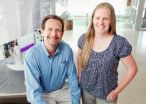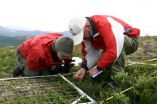(Press-News.org) We've all seen the story in the news before. Whether it's the death of a physically fit high school athlete at football training camp in August, or of an elderly woman gardening in the middle of the day in July, heat stroke is a serious, life-threatening condition for which there is no treatment beyond submersion in ice water or the application of ice packs to cool the body to a normal temperature.
But, in a new study published today in the journal Nature Medicine, scientists discovered what they believe is one of the first drugs to combat heat stroke. AICAR – an experimental therapy once dubbed the "couch potato pill" for its ability to mimic the effects of exercise in sedentary mice – protected animals genetically predisposed to the disorder and may hold promise for the treatment of people with enhanced susceptibility to heat-induced sudden death.
"There is a great need for the training staff of athletic teams, physicians in emergency rooms in places like Phoenix, and soldiers serving in the deserts of the Middle East to have a drug available to give to individuals during a heat stroke event," said Robert T. Dirksen, Ph.D., study author and professor of Pharmacology and Physiology at the University of Rochester Medical Center. "Our study takes an important first step towards developing a new drug therapy that may be part of the standard treatment regimen for heat stroke in the future."
The finding comes as heat stroke cases are on the rise. According to a recent study in the American Journal of Preventive Medicine, the number of heat-related injuries in the U.S. more than doubled from 1997 to 2006. In that 10-year period, an estimated 55,000 people were treated for the condition in emergency rooms across the country.
The research team, led by Dirksen's long-time collaborator Susan L. Hamilton, Ph.D., from Baylor College of Medicine, tested the drug in mice with a mutation in the RYR1 gene. The mutation is associated with malignant hyperthermia, a life-threatening inherited disorder of skeletal muscle in which commonly used general anesthetics trigger uncontrolled muscle contractions and dangerous increases in body temperature. Unexpectedly, further work demonstrated that these mice exhibit similar uncontrolled muscle contractions – a classic heat stroke response – during exposure to high temperatures or when exercising under warm conditions.
The team found that AICAR administration protected the mice from experiencing such contractions under heat stress. If not stopped, the contractions cause muscles to break apart and release their contents, including potassium and proteins, into the blood. High levels of potassium in the blood are extremely toxic and, if not treated quickly, can cause cardiac arrhythmias and death.
Unfortunately, the drug didn't deliver the same positive result for anesthetic-induced malignant hyperthermia.
AICAR made a big splash in 2008 when a study published in Cell, a prestigious scientific journal, found that the drug built muscle and increased endurance in completely inactive mice. As additional studies further established AICAR's ability to improve muscle function, the team grew curious to test how it might influence the whole-body muscle contractions characteristic of RYR1-associated heat stroke in mice.
Not only did they discover the unanticipated protective effect of the drug, but that it worked in a completely different way than they originally thought.
AICAR normally works by activating the body's metabolic "master switch," an enzyme called AMPK that, among other things, influences muscle activity. However, researchers found that the ability of the drug to protect the mice from heat stroke was unrelated to its effects on this master switch. Rather, it directly influenced RYR1.
RYR1, or the type 1 ryanodine receptor, is a protein that plays an essential role in muscle contraction. It is responsible for releasing positively charged calcium ions from storage compartments within cells, which then combine with muscle proteins to trigger contraction. In response to heat, mutations in RYR1 cause excessive amounts of calcium to leak from the storage compartment and trigger uncontrolled muscle contractions. The team found that AICAR reduces calcium leakage from RYR1, thus diminishing heat-induced contractions, muscle damage, and death.
In a separate but related article published in the journal Anesthesiology, Dirksen and colleagues reported cases of two children with RYR1 mutations who died following episodes triggered by either a viral fever or exposure to environmental heat stress. The team points out that while RYR1 mutations may only account for a small subset of heat stroke cases in the general population, they believe their finding that AICAR is protective against heat stroke is likely to apply more broadly.
"We think the fundamental process that occurs during heat stroke in individuals with RYR1 mutations is likely to be similar to what happens even in their absence. The difference may be that individuals with RYR1 mutations are more easily thrust into the process, whereas those without need to be pushed more – for example, by exposure to even greater temperatures or a longer time – in order to move beyond a critical threshold," noted Dirksen.
The team plans to study the efficacy of AICAR in other models of heat- and exercise-induced disorders.
Though no couch potato pill has come to fruition yet, AICAR is currently under investigation for the treatment of certain muscle diseases and metabolic disorders where exercise is known to be beneficial.
###
This research was supported by grants from the National Institute of Arthritis and Musculoskeletal and Skin Diseases at the National Institutes of Health, the Department of Defense and the Muscular Dystrophy Association of America. In addition to Dirksen, Research Assistant Professor Viktor Yarotskyy, Ph.D., and graduate student Alina Ainbinder from the University of Rochester Medical Center participated in the research. Several scientists from Hamilton's team at Baylor College of Medicine and one from the Joslin Diabetes Center in Boston also contributed significantly to the work.
'Couch potato pill' might stop heat stroke too
2012-01-09
ELSE PRESS RELEASES FROM THIS DATE:
Colorado mountain hail may disappear in a warmer future
2012-01-09
Summertime hail could all but disappear from the eastern flank of Colorado's Rocky Mountains by 2070, according to a new modeling study by scientists from NOAA and several other institutions.
Less hail damage could be good news for gardeners and farmers, said Kelly Mahoney, Ph.D., lead author of the study and a postdoctoral scientist at NOAA's Earth System Research Laboratory in Boulder, Colo. But a shift from hail to rain can also mean more runoff, which could raise the risk of flash floods, she said.
"In this region of elevated terrain, hail may lessen the risk of ...
New test spots early signs of inherited metabolic disorders
2012-01-09
A team of scientists, led by researchers at the University of California, San Diego School of Medicine and Zacharon Pharmaceuticals, have developed a simple, reliable test for identifying biomarkers for mucopolysaccharidoses (MPS), a group of inherited metabolic disorders that are currently diagnosed in patients only after symptoms have become serious and the damage possibly irreversible.
The findings will be published online January 8 in the journal Nature Chemical Biology.
MPS is caused by the absence or malfunctioning of a lysosomal enzyme required to break down ...
Evolution of complexity recreated using 'molecular time travel'
2012-01-09
Much of what living cells do is carried out by "molecular machines" – physical complexes of specialized proteins working together to carry out some biological function. How the minute steps of evolution produced these constructions has long puzzled scientists, and provided a favorite target for creationists.
In a study published early online on Sunday, January 8, in Nature, a team of scientists from the University of Chicago and the University of Oregon demonstrate how just a few small, high-probability mutations increased the complexity of a molecular machine more than ...
Team finds a better way to gauge the climate costs of land use changes
2012-01-09
CHAMPAIGN, Ill. — Those making land use decisions to reduce the harmful effects of climate change have focused almost exclusively on greenhouse gases – analyzing, for example, how much carbon dioxide is released when a forest is cleared to grow crops. A new study in Nature Climate Change aims to present a more complete picture – to incorporate other characteristics of ecosystems that also influence climate.
"We know that forests store a lot of carbon and clearing a forest releases carbon dioxide into the atmosphere and contributes to climate change," said University of ...
Graphene reveals its magnetic personality
2012-01-09
In a report published in Nature Physics, they used graphene, the world's thinnest and strongest material, and made it magnetic.
Graphene is a sheet of carbon atoms arranged in a chicken wire structure. In its pristine state, it exhibits no signs of the conventional magnetism usually associated with such materials as iron or nickel.
Demonstrating its remarkable properties won Manchester researchers the Nobel Prize in Physics in 2010.
This latest research led by Dr Irina Grigorieva and Professor Sir Andre Geim (one of the Nobel prize recipients) could prove crucial ...
European mountain vegetation shows effects of warmer climate
2012-01-09
The decade from 2000 to 2009 was the warmest since global climate has been measured, and while localized studies have shown evidence of changes in mountain plant communities that reflect this warming trend, no study has yet taken a continental-scale view of the situation – until now.
With the publication of "Continent-wide response of mountain vegetation to climate change," scheduled for Advance Online Publication (AOP) in Nature Climate Change on 8 January, researchers from 13 countries report clear and statistically significant evidence of a continent-wide warming effect ...
EditCopyProof Launches Fresh Website Catering To Niche Copywriting Needs of Evolutionary Entrepreneurs
2012-01-09
Founder of EditCopyProof, Charlon Bobo, today announced the official launch of a new website featuring products and services specifically developed for evolutionary entrepreneurs. As one of only a few businesses worldwide addressing the specific needs of this market, Bobo is the only copywriter.
Affectionately known as the "conscious copywriter," Bobo enjoys the success of a worldwide clientele and a loyal following of evolutionary entrepreneurs; a quickly-emerging market. The term is a relatively new one, coming onto the business scene within the past year.
Evolutionary ...
2 genes affect anxiety, behavior in mice with too much MeCP2
2012-01-09
HOUSTON -- (Jan. 8, 2012) – The anxiety and behavioral issues associated with excess MeCP2 protein result from overexpression of two genes (Crh [corticotropin-releasing hormone] and Oprm 1 [mu-opioid receptor MOR 1]), which may point the way to treating these problems in patients with too much of the protein, said Baylor College of Medicine scientists in a report that appears online in the journal Nature Genetics.
Much of the work was done at the Jan and Dan L. Duncan Neurological Research Institute at Texas Children's Hospital.
MeCP2 is a "Goldilocks" in the protein ...
Global warming caused by greenhouse gases delays natural patterns of glaciation, researchers say
2012-01-09
GAINESVILLE, Fla. --- Unprecedented levels of greenhouse gases in the Earth's atmosphere are disrupting normal patterns of glaciation, according to a study co-authored by a University of Florida researcher and published online Jan. 8 in Nature Geoscience.
The Earth's current warm period that began about 11,000 years ago should give way to another ice age within about 1,500 years, according to accepted astronomical models. However, current levels of carbon dioxide are trapping too much heat in the atmosphere to allow the Earth to cool as it has in its prehistoric past ...
Mark Quiroz Hired as New Senior Pastor of First Evangelical Methodist Church of Glendora
2012-01-09
First Evangelical Methodist Church of Glendora is pleased to announce the official hiring of Mark Quiroz as their new Senior Pastor. He will be replacing the churches long time dedicated pastor Wenzel Sperl who passed away on September 26, 2011.
Pastor Quiroz brings to Glendora EMC, five years of church leadership as Youth Pastor of multiple churches. He graduated in 2011 with a Bachelors of Science Degree in Christian Ministry from Crown College in Minnesota. He is currently enrolled in the Master of Ministry program at Point Loma University in San Diego.
For more ...


